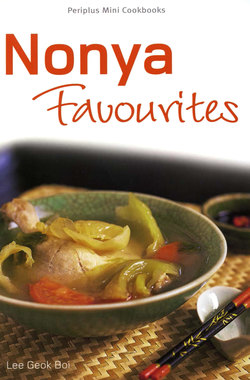Читать книгу Mini Nonya Favourites - Lee Geok Boi - Страница 5
На сайте Литреса книга снята с продажи.
ОглавлениеGlossary
Asam Gelugor: The dried slices of the sour fruit, garcinia atnoviridis, are sometimes used in place of tamarind pulp in Nonya dishes. If asam gelugur is not available, substitute with tamarind pulp.
Belacan: Shrimp paste is a quintessential ingredient in Nonya and Malay food. It comes in blocks and can vary from soft to firm and be a lurid pink or a dark gray-brown colour. It is now also available bottled in powder form. Although used in small amounts, the quality of the belacan affects the final flavour of the dish. Many Nonyas will swear by Penang belacan which is also my personal preference. If you are uncertain of the quality of your belacan, for example, if you think it smells rather strong, use less rather than more. Not enough is better than too much to prevent an imbalance in the flavours of your spice paste. The traditional way to measure belacan was by slices, but the best way to get a uniform measure is by spoonfuls. To measure, press some belacan into the measuring spoon and level off with a knife.
Cai Xin: A cousin of Chinese kale, cai xin, or choi sum as it is often known as, is one of the most versatile of Chinese greens. The easier it is to pierce the base of the stem with a fingernail, the more tender the vegetable.
Candlenuts: A round, cream-coloured waxy nut, often known by its Malay name, buah keras. Candlenuts are added to Nonya dishes for both flavour and texture, as they help to thicken a sauce.
Coconut Milk: Coconut milk is another essential Nonya ingredient. Fresh is best but UHT coconut milk works well for practically all Nonya dishes where the coconut milk has to be cooked. The coconut cream used in these recipes is UHT coconut cream which is very thick. Too much coconut milk in a curry or sambal makes a dish too rich besides being a cholesterol nightmare. However, too little will not bring out the flavours properly. The richness can be varied to suit personal tastes.
Fermented Soya Beans: known as dou jiang and usually sold in jars with the soft fermented and salted soya beans doused in a brownish liquid. The beans are usually mashed before using.
Galangal: Often measured by the thumb but it can also be measured by slices. Naturally, the measure can vary depending on the size of the root. However, it is not all that critical to get the quantity spot on.
Kale: Known by its Chinese name, kai Ian, or baby kai Ian for the smaller, rounder version. Kale has a robust flavour and texture and is slightly bitter. Although the lowest, hardest part of the stem may be discarded, the remainder should be cooked and enjoyed for its mild, crisp pith.
Lemongrass: Usually measured by the stalks. However, lemongrass is rarely uniform in size and some stalks can be rather small. Cup measures are therefore given to ensure a constant measure. Only the white bulbuous part of the stalk is used—this is the most fragrant part—the greenish upper part of the stalk is discarded. Trim away the woody root and peel away any dried-up outer layers. Slice thinly first to make blending easier.
Screwpine Leaves: Pandan leaves impart a subtle flavour to many Nonya dishes, both savoury and sweet. The leaves are either tied and left in the pot for savoury dishes, or pounded to extract the green colouring for desserts.
Tamarind: Dried tamarind fruits are often available in the form of a pulp which must be soaked in water, stirred, squeezed and strained to yield a sour yet flavoursome liquid. All forms of solids and remaining pulp should be discarded.
